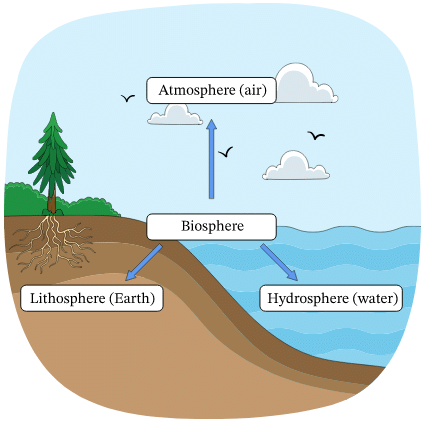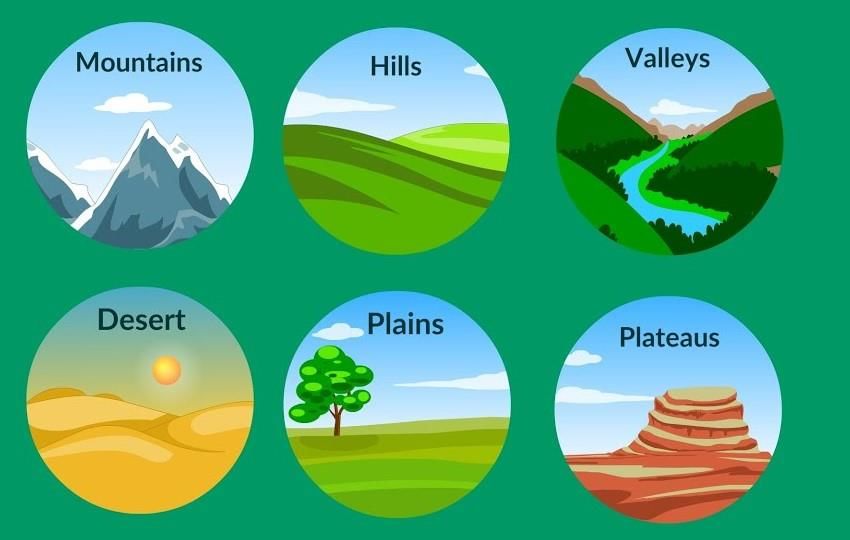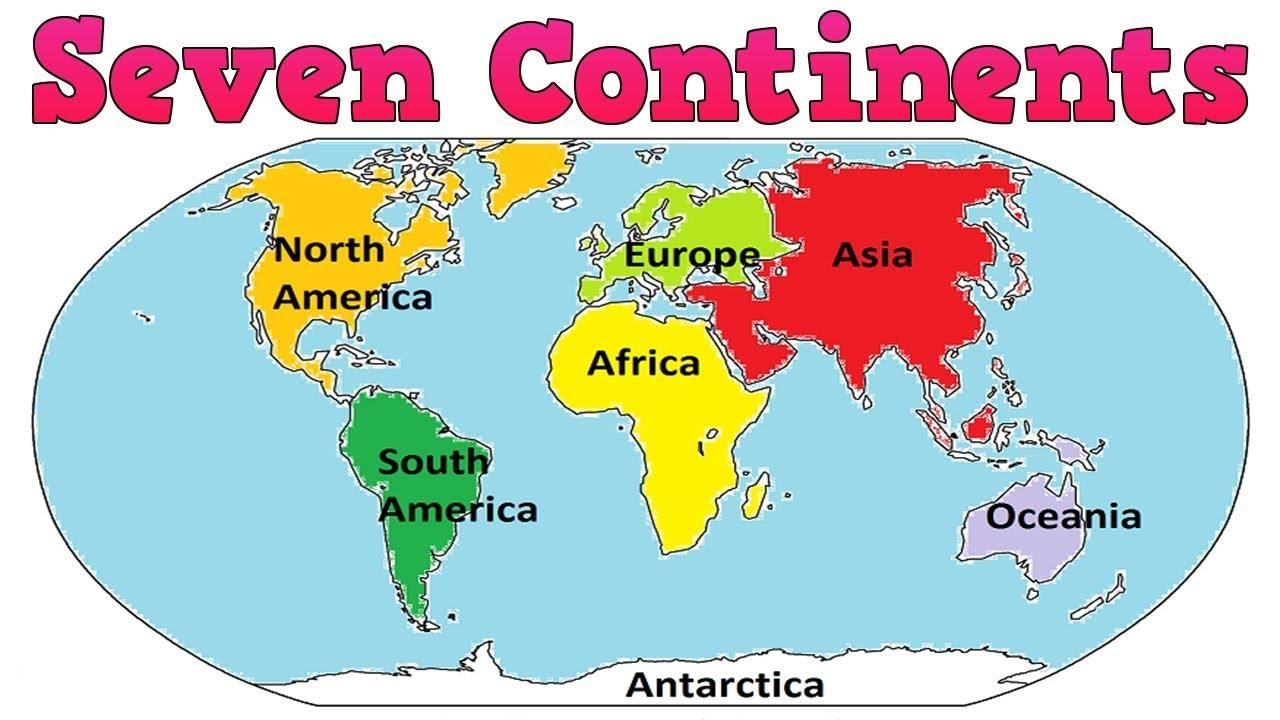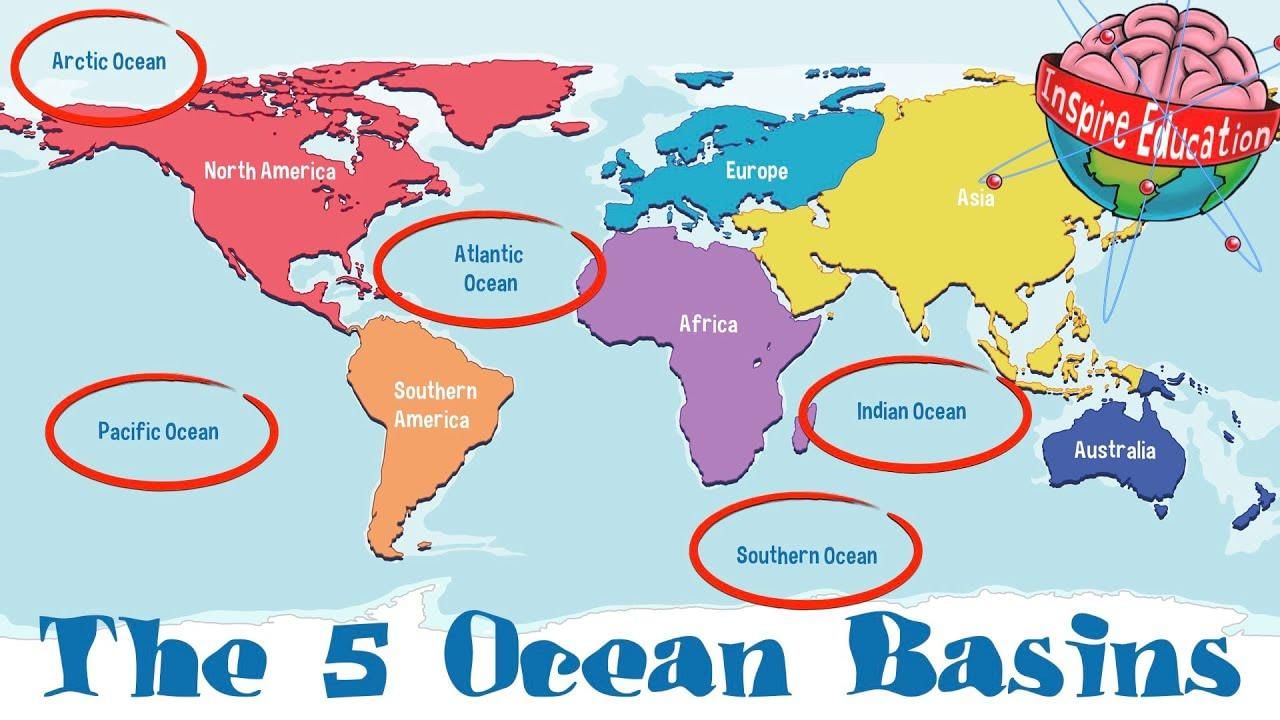The Four Domains and Major Landforms Chapter Notes | Science for Grade 4 PDF Download
| Table of contents |

|
| Introduction |

|
| The Four Domains of the Earth |

|
| Major Landforms of the Earth |

|
| Continents of the World |

|
| Oceans of the World |

|
Introduction
Earth is our home, and it has many different parts like land, water, air, and living things. This chapter tells us about the four big parts of Earth called domains. These are lithosphere, hydrosphere, atmosphere, and biosphere. We will also learn about the different shapes of land like mountains, valleys, and plains, and about water bodies like rivers and oceans. Let’s explore how these parts work together to make Earth a special place for us to live!
The Four Domains of the Earth
- Earth has four big parts called domains: land, air, water, and living things.
- The part with land is called lithosphere.
- The part with water is called hydrosphere.
- The part with air is called atmosphere.
- The part where living things like plants, animals, and humans live is called biosphere.
- All these four parts work together to support life on Earth.

Four Domains of the earth are:
1. Lithosphere
- Lithosphere is the hard, outer part of the Earth made of rocks, minerals, and soil.
- We call this part land, and it comes from the mountains to the sea floor.
- About three-fourths of the land has irregular shapes like mountains, hills, plateaus, plains, valleys, and water bodies.
- Land gives humans a place to live, grow food, build homes, and take care of animals.
- Land also has minerals that we use for many things.
2. Hydrosphere
- Hydrosphere is all the water on Earth, like rivers, lakes, seas, oceans, and groundwater.
- Earth is called the blue planet because more than three-fourths of it is covered with water.
- Water supports living things like fish, turtles, crabs, whales, and plants in rivers, seas, oceans, ponds, and lakes.
- We get groundwater from wells and tube wells for drinking and other uses.
- Some water is frozen in glaciers and ice caps, and some is in the air as moisture.
- Water is very important for humans, animals, and plants to live.
- Most of Earth’s water is in oceans, but ocean water is salty and not good for drinking.
- Only a small amount of water is available for humans to use.
3. Atmosphere
- Atmosphere is the layer of air around the Earth.
- It is made of gases like nitrogen, oxygen, carbon dioxide, hydrogen, and helium, plus dust and water vapor.
- The atmosphere goes up to more than 10,000 km above the Earth’s surface.
- It keeps the Earth warm by trapping heat from the sun.
- The atmosphere has many layers, and one layer has ozone, which protects us from harmful sun rays.
- Changes in the atmosphere cause changes in weather and climate.
4. Biosphere
- Biosphere is the part of Earth where land, water, and air work together to support life.
- All living things like insects, plants, birds, animals, and humans live in the biosphere.
- The biosphere supports life on land, in water, and in the air, like birds in the sky and fish in the ocean.
- Biosphere is a mix of the lithosphere (land), hydrosphere (water), and atmosphere (air).
- All these parts depend on each other to keep life going on Earth.
Major Landforms of the Earth
- The Earth’s surface is not the same everywhere.
- Some parts are high, some are low, some are flat, and some are steep.
- Some areas have water, and some do not.
 Let’s learn about the different shapes of land on Earth:
Let’s learn about the different shapes of land on Earth:
1. Mountain
- A mountain is a high piece of land with sloping sides and a sharp top called a peak.
- Very high mountains are covered with snow all year round.
- A small mountain is called a hill.
- A chain of mountains is called a mountain range.
- The Himalayas in the north of India is a mountain range.
- Mount Everest is the highest mountain peak in the world.
Fun Fact
Edmund Hillary and Tenzing Norgay Sherpa were the first men to climb the highest mountain peak, Mt. Everest, in 1953.
2. Valley
- A valley is a low area between hills or mountains.
- It usually has a river or stream running through it.
- Kashmir valley and Kangra valley in India are examples of valleys.
3. Plateau
- A plateau is a high piece of land with a flat top, like a table, so it is also called table land.
- Deccan Plateau in India and Tibet Plateau in China are examples of plateaus.
4. Plains
- Plains are large areas of flat, low land.
- They have good soil for growing crops.
- The Ganga Plain and the Indus Plain in India are examples of plains.
- Many people live in plains because the flat land helps in building roads, railways, buildings, and industries.
5. Desert
- A desert is a dry area with very little rain and very little greenery.
- Deserts are very hot in summer and very cold in winter.
- The Sahara desert in North Africa is the largest desert in the world.
- The Thar desert is an example of a desert in India.
6. Water Bodies
Earth has many water bodies like rivers, lakes, seas, and oceans.
River
- A river is a water body that flows from mountains to a sea or a plain.
- Small rivers are called streams.
- Many streams join together to form a large river.
- The starting point of a river is called its source.
- The ending point of a river is called its mouth.
- River Amazon and River Nile are the two longest rivers in the world.
- Ganga is the longest river in India.
Lake
- A lake is a large water body surrounded by land on all sides.
- It is a low area where water collects from rain, rivers, or glaciers.
- Water in a lake does not flow like a river.
- Lakes can have fresh water (like Wular Lake and Dal Lake in Kashmir, India) or salty water (like Sambhar Salt Lake in Rajasthan and Chilika Lake in Odisha).
- Lakes can be natural or man-made.
Sea
- A sea is a large body of salt water surrounded fully or partly by land.
- Arabian Sea and Bay of Bengal are examples of seas.
Ocean
- An ocean is a very large and deep body of salt water.
- It is bigger than a sea and is far away from land.
- Indian Ocean is an example of an ocean.
Continents of the World
- Big landmasses on Earth are called continents.
- Earth has seven continents: Asia, Africa, North America, South America, Antarctica, Europe, and Australia.

1. Asia
- Asia is the largest continent in the world.
- It covers about one-third of the total land area of the Earth.
- Asia is in the Northern Hemisphere.
- India is a part of Asia.
2. Europe
- Europe is to the west of Asia in the Northern Hemisphere.
- It is smaller than Asia.
- The landmass of Europe, along with Asia, is called Eurasia.
3. Africa
- Africa is the second largest continent in the world.
- A large part of Africa is in the Northern Hemisphere.
- It is surrounded by oceans and seas on all sides.
4. North America
- North America is the third largest continent in the world.
- It is completely in the Northern and Western Hemisphere.
5. South America
- South America is the fourth largest continent in the world.
- It is mostly in the Southern Hemisphere.
6. Australia
- Australia is the smallest continent in the world.
- It is completely in the Southern Hemisphere.
- It is an island continent surrounded by seas and oceans on all sides.
7. Antarctica
- Antarctica is a large continent in the Southern Hemisphere near the South Pole.
- It is the coldest continent in the world.
- People do not live in Antarctica, except for scientists who study this region.
Oceans of the World
- Oceans are very big salt water bodies that surround the continents.
- Earth has five oceans: Pacific Ocean, Atlantic Ocean, Indian Ocean, Arctic Ocean, and Antarctic Ocean.

1. Pacific Ocean
- Pacific Ocean is the largest and deepest ocean in the world.
- It separates the continents of Asia and Australia from North and South America.
3. Atlantic Ocean
- Atlantic Ocean is the second largest ocean in the world.
- North and South America are on its western side, and Europe and Africa are on its eastern side.
4. Indian Ocean
- Indian Ocean is named after India.
- It lies to the south of Asia.
5. Arctic Ocean
- Arctic Ocean is the smallest ocean in the world.
- It lies near the North Pole and is frozen all year round.
6. Antarctic Ocean
- Antarctic Ocean is also called the Southern Ocean.
- It lies in the far south of the world around the continent of Antarctica.
Points To Remember
- Earth has four domains or spheres: lithosphere, hydrosphere, atmosphere, and biosphere.
- The sphere with land is called lithosphere.
- The sphere with water is called hydrosphere.
- The sphere with air is called atmosphere.
- The sphere where living things live is called biosphere.
- All these spheres depend on each other.
- Earth has many landforms: mountains, valleys, plateaus, plains, deserts, and more.
- Water bodies on Earth include rivers, lakes, seas, and oceans.
- Large landmasses are called continents, and there are seven continents.
- Large water bodies are called oceans, and there are five oceans.
Glossary
- Moisture: Amount of water vapor present in the air
- Harsh: Difficult for people, animals, and plants to live in
- Vegetation: Greenery due to plants
|
28 videos|132 docs|42 tests
|
FAQs on The Four Domains and Major Landforms Chapter Notes - Science for Grade 4
| 1. What are the four domains of the Earth? |  |
| 2. What are some major landforms found on Earth? |  |
| 3. How many continents are there in the world and what are their names? |  |
| 4. What are the five oceans of the world? |  |
| 5. What key points should be remembered about the Earth's domains and landforms? |  |















